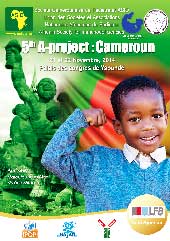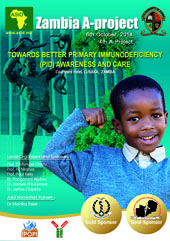Yousif Abdalla, Idriss Matoug, Hanan Alsalheen. Children's Hospital, Faculty of Medicine, Benghazi University, Benghazi, Libya.
Agammaglobulinemia is a primary immunodeficiency disease. Affected children presented a blockade in maturation of B-cells in the bone marrow which leads to low or absent serum immunoglobulin levels (1). There are three types: X-linked, early onset, and late onset.
In X-linked agammaglobulinemia (Bruton agammaglobulinemia) , there is a mutation in Bruton tyrosine kinase (BTK) gene which is responsible for about 90% of early onset agammaglobulinemia with low or absent B cells.
Late onset agammaglobulinemia is usually due to common variable immunodeficiency. The other type is early onset non-Bruton agammaglobulinemia, which is mostly due to autosomal recessive/dominant inheritance (2,3,4). In autosomal recessive agammaglobulinemia, the child usually suffers from infections in the first few years of life (the clinical features are similar to that seen in children with X-linked agammaglobulinemia) and has low serum immunoglobulin levels and absent B lymphocytes in the peripheral blood (5).
Our aim was to describe the clinical presentations of two cousins with non-Bruton agammaglobulinemia.
Case 1: 6 years old boy born from consanguineous parents who presented since the age of 4 months with recurrent chest infection and recurrent bilateral purulent conjunctivitis. His sister was also affected (see figure).
Case 2: 7 years old girl who had recurrent chest and sinus infections since the age of 3 months. Her sister died at age of one year out of recurrent chest infections.
Clinical examination of both children revealed no palpable lymph nodes, tonsillitis nor organomegaly . The laboratory investigations of both cases showed absent B lymphocytes (CD19+) with low serum level of immunoglobulins ( IgG, IgM and IgA ) in comparison to reference ranges for age.
These cousins represent form of early onset non-Bruton agammaglobulinemia; most probably
autosomal recessive, as we noted the parental consanguinity and the presence of two affected females in the kindred.
Intravenous γ-globulin was given monthly for both cases. During follow up, patients were still developing infections. Serum trough levels of IgG were found to be suboptimal. Thus the dose of Intravenous γ-globulin dose was increased. Once the optimum level was reached, the recurrent conjunctivitis in the first case as well as the chronic sinusitis in the second case improved.
Conclusion : Children with non-Bruton agammaglobulinemia usually develop recurrent infections in early months of life, and low IgG trough level due to insufficient γ-globulin infusions can lead to recurrent and persistent infections.
Recommendation: Agammaglobulinemia should be considered in the differential diagnosis of children with recurrent infections in the early months of life. Monitoring of serum IgG trough level is essential until optimum levels are achieved to prevent further morbidities.
Figure showing family pedigree of the two cases

References :
1. LougarisV, Ferrari S, Cattalini M, Soresina A, Plebani A. Autosomal recessive agammaglobulinemia: novel insights from mutations in Ig-beta.CurrAllergy. Asthma Rep. 2008 Sep;8(5):404-8
2. York NR, de la Morena MT. 50 years ago in the journal of pediatrics: a decade with agammaglobulinemia. J Pediatr. May 2012;160(5):756.
3. Khan WN. ColonelBruton'skinase defined the molecular basis of X-linked agammaglobulinemia, the first primary immunodeficiency. J Immunol. Apr 1 2012;188(7):2933-5.
4. Samson M, AudiaS, Lakomy D, et al. Diagnostic strategy for patients with hypogammaglobulinemia in rheumatology. Joint Bone Spine. May 2011;78(3):241-5.
5.FerrariS, ZuntiniR, LougarisV, Soresina A, SourkováV, Fiorini Met al. Molecular analysis of the pre-BCR complex in a large cohort of patients affected by autosomal-recessiveagammaglobulinemia. Genes Immun. 2007 Jun;8(4):325-33



























